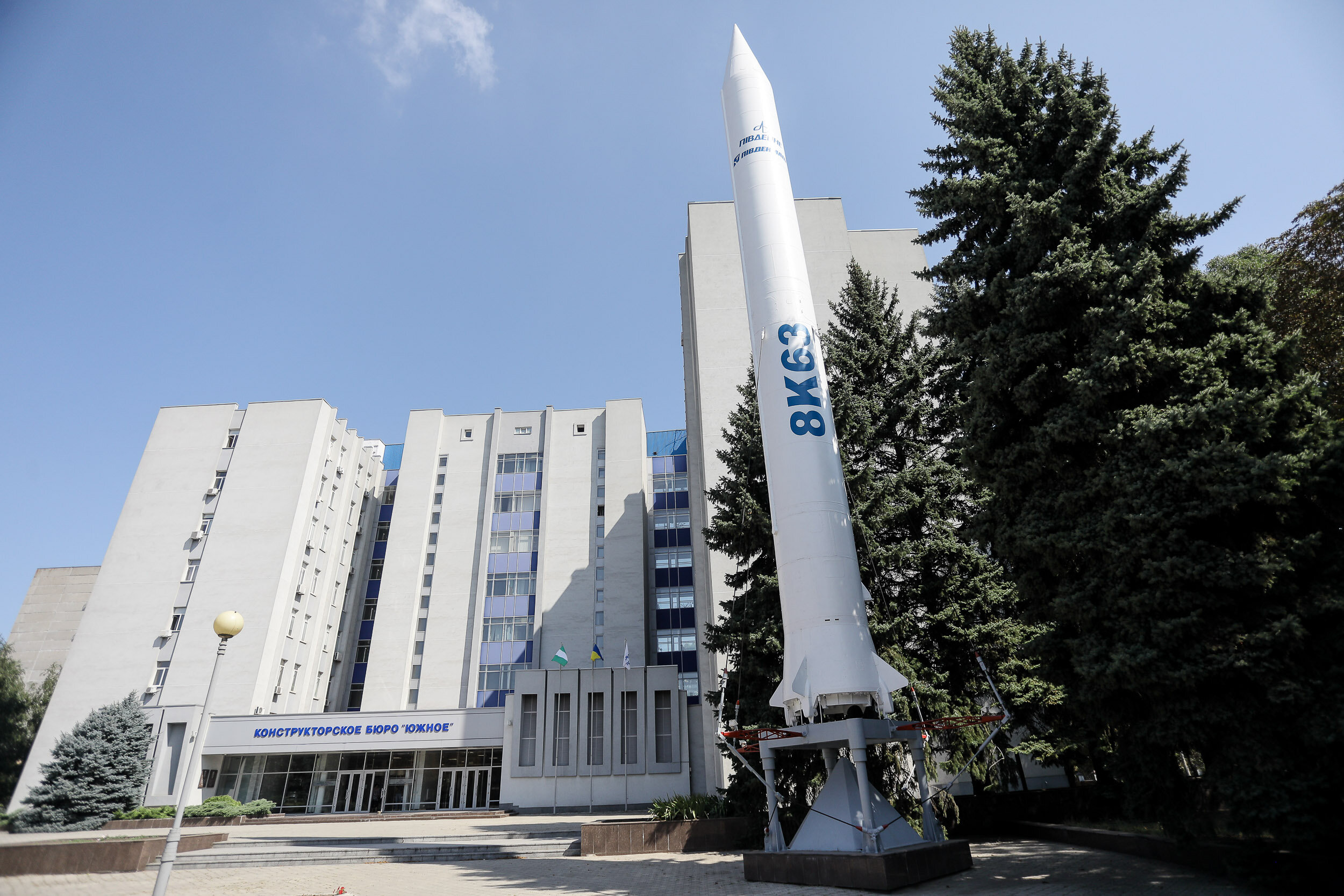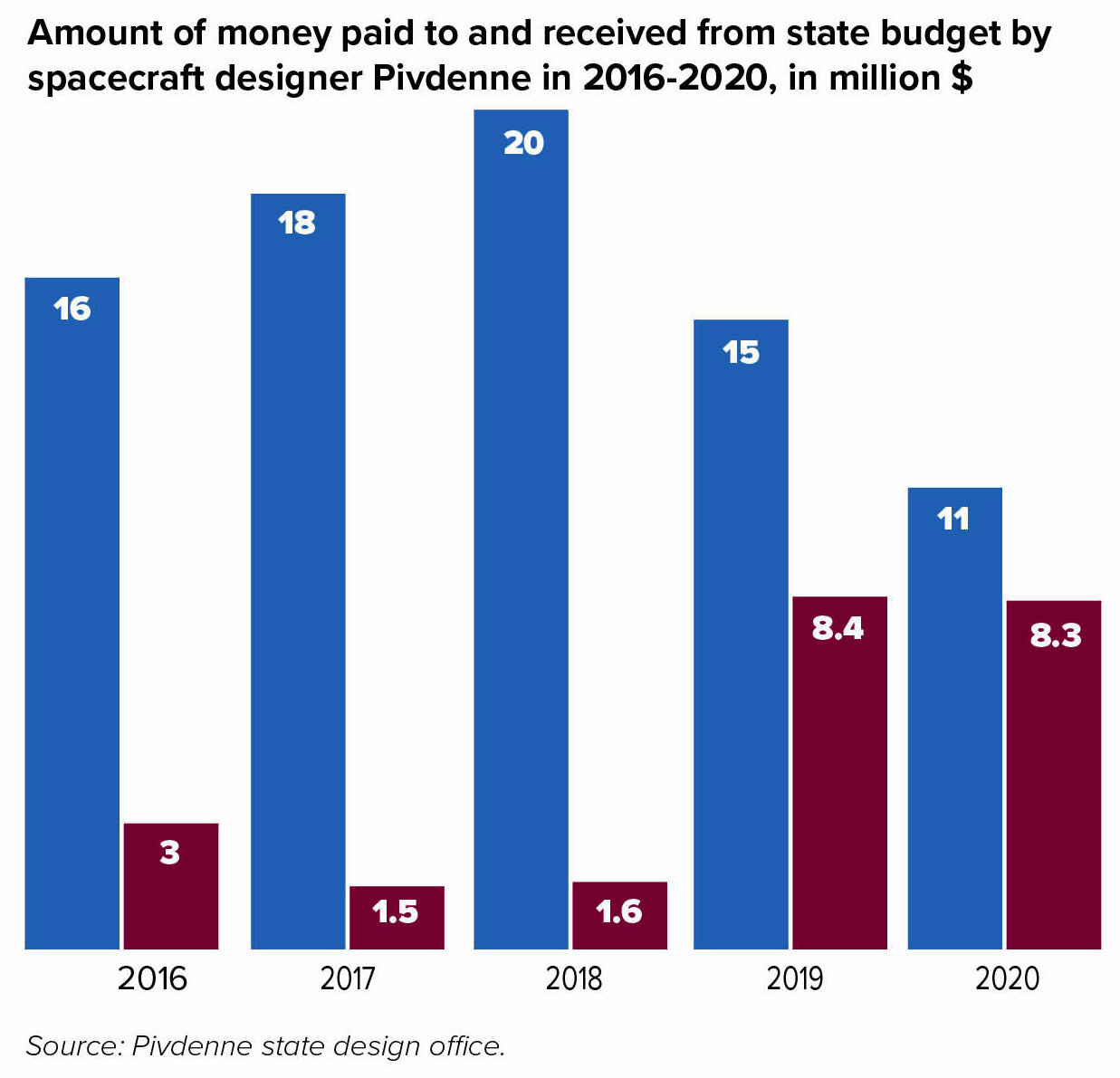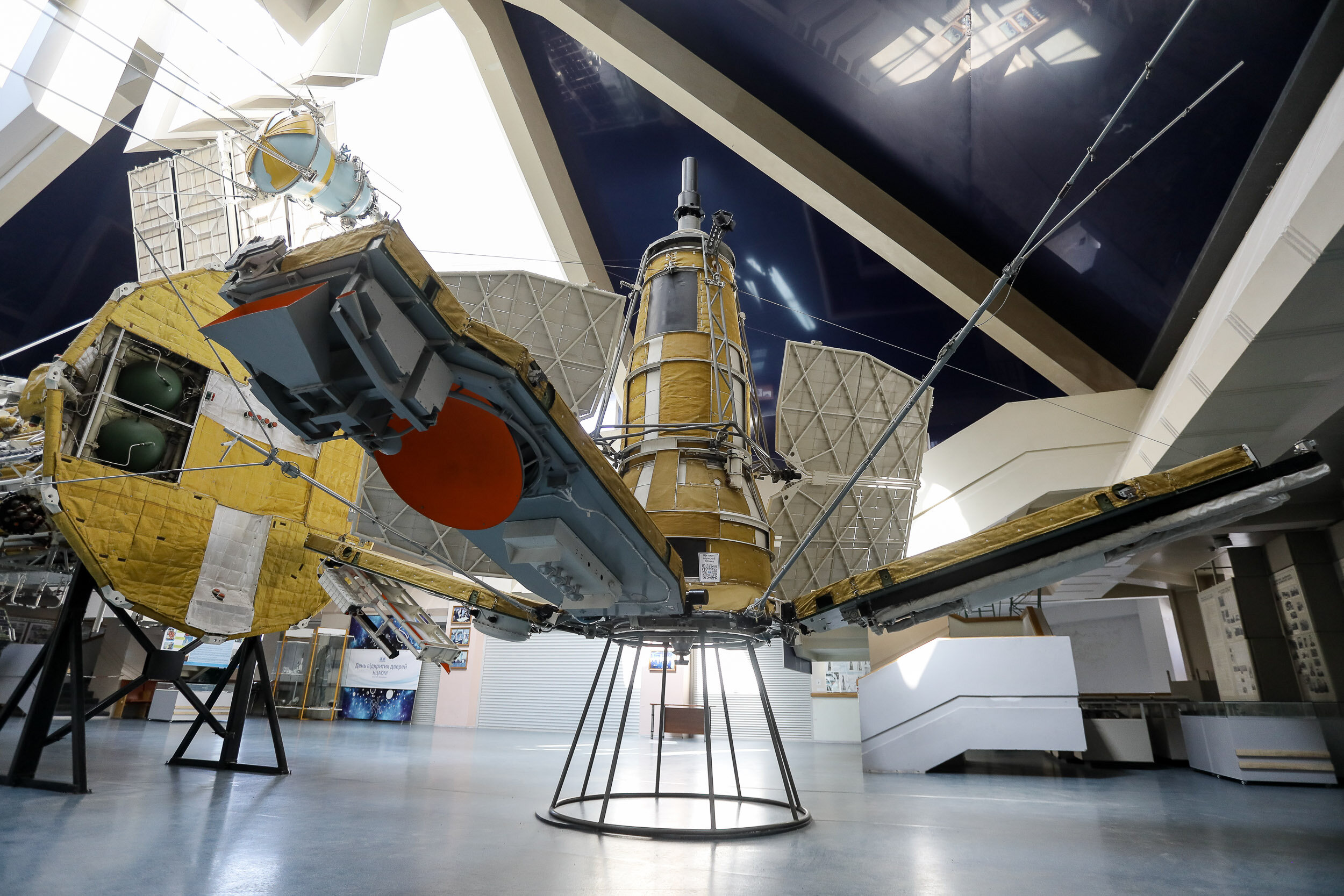DNIPRO — Time took a toll on Ukraine’s state-owned spacecraft design bureau Pivdenne.
Compared to high-tech offices of U.S. space firms like Virgin Galactic or SpaceX, Pivdenne’s premises look like a relic, with its dusty floor, old wooden tables and barbed wire fence.
The design bureau located in Dnipro, a city of about one million people 480 kilometers southeast of Kyiv, comprises several khrushchyovka-style five-story buildings surrounding a central office next to a full-size model of an R‑12 ballistic missile, which caused the Cuban Missile Crisis in 1962.
This plus the full-size model of a Soviet R‑36 ballistic missile installed in the facility’s backyard, are the only signs of the bureau’s glorious past.
Once the cradle of USSR’s most advanced space technology, the agency slowly declined over the decades, mired in corruption and political intrigues.
The future of the enterprise is uncertain, but the agency can use its past to survive. Known globally as one of the USSR’s best spacecraft designers, this legacy can help Pivdenne secure contracts with foreign businesses and the state.

A view to the main office of spacecraft designer Pivdenne in Dnipro, pictured on Aug. 17, 2021. The full-size model of the R-12 ballistic missile installed in front of the office reminds visitors about the enterprise’s glorious past. (Oleg Petrasiuk)
Global interest
The enterprise’s rocket production cycle — from design and manufacturing to maintenance and utilization — dates back to the Space Race between the U.S. and the USSR at the end of the 20th century.
Space rockets like Zenit, Dnipro, Cyclone and Kosmos, designed by Pivdenne and manufactured by a giant spaceship factory Pivdenmash in Dnipro, are well-known globally: They went to space nearly 500 times in the last 60 years.
Pivdenne is an old-school space giant, producing $38 million worth of products and paying $11 million in taxes with a net profit of only $408 last year. Nearly 90% of its production goes abroad — Ukraine doesn’t produce launch vehicles and satellites for itself.
Globally, the U.S. and Europe — the main markets for Pivdenne — start to hire local contractors for space projects, rather than outsource the work overseas. To stay productive and profitable, Pivdenne has to offer foreign clients cheap and high-quality products or make rockets and satellites for Ukraine.
In the next five years, Ukraine wants to launch seven satellites, build its own spaceport and a carrier vehicle. Pivdenne will compete for these projects with Ukraine’s private space businesses — young, ambitious and backed by investors.
And the state-owned behemoth isn’t afraid of the competition.
“Globally, we compete with big international companies like Boeing, so it is not serious to be bothered by private Ukrainian firms,” said Maxim Degtyarev, the chief designer at Pivdenne.

Chief designer at Ukraine’s state-owned spacecraft design office Pivdenne Maxim Degtyarev poses for a photo during an interview with the Kyiv Post on Aug. 17, 2021. (Oleg Petrasiuk)
The Ukrainian government has made the first step to get its once legendary space industry back into orbit. In December, Pivdenne will launch the satellite Sich 2–30 into space. But it may not be enough to save the agency, which relies heavily on projects abroad.
The bureau designed the first stage for NASA’s rocket Antares that lifts payloads to the International Space Station (ISS). Since 2013, Antares has flown 14 successful missions to the ISS.
Another big contract is the production of engines for the European Space Agency’s rocket Vega, which has made 19 launches since 2012.
“These are very important projects that bring money and allow Pivdenne to work on international markets,” Degtyarev said.
Pivdenne signed long-term contracts with Vega and Antares and continued working with them even during the COVID‑19 quarantine of 2020. Pivdenne receives money for the maintenance of rockets during every launch.
Space industry experts told the Kyiv Post that contracts with Antares and Vega help the enterprise to stay afloat and pay salaries at a time when smaller projects are suspended.
“But these contracts are not perpetual,” said Volodymyr Usov, the former head of Ukraine’s State Space Agency in an interview with the Kyiv Post in July.
Starting in 2024, Vega, for example, won’t use Ukrainian engines — it plans to replace them with the engines produced by the members of the European Space Agency, according to one of the Kyiv Post’s sources.

A Northrop Grumman Antares rocket with Ukrainian-produced first stage launches from Pad-0A at NASA’s Wallops Flight Facility in Wattsville, Virginia, the United States, on February 15, 2020. (AFP)
Local projects
Although Pivdenne can design modern rockets and Pivdenmash can produce them, Ukraine can’t order such a sophisticated space tech yet, because it lacks funds and a Ukrainian spaceport to launch them.
Having its own spaceport would be economically beneficial for Ukraine, according to Volodymyr Taftay, chief of the State Space Agency o
f Ukraine. But Ukraine’s space enterprises cannot build the spaceport until the government approves a space program to attract funds thanks to state orders.
Pivdenne is now busy with another state project — the launch of the satellite Sich 2–30 that will go to space with SpaceX’s rocket Falcon 9.
According to Degtyarev, the satellite is now ready, having passed the last stages of testing. Ukraine will send it to the U.S. at the beginning of November.
The launch of Sich 2–30 is a big milestone for Pivdenne and Ukraine. In the last 10 years, the country didn’t have its own satellite and spent thousands of dollars buying data from the EU, China or the U.S.
Nonetheless, Sich 2–30 is not perfect. Designed in 2015, it is too heavy and outdated, experts said. Compared to light modern satellites, Sich 2–30 weighs over 170 kilograms and takes low-resolution pictures that can hardly be used in military intelligence, experts said.
According to Degtyarev, Sich 2–30 is an “overview” satellite.
“Ukraine will have satellites that will produce more detailed images. But to launch them, we need to know where to look,” Degtyarev said.

The photo shows the Ukrainian satellite Sich 2–30, located at Ukraine’s spacecraft design office Pivdenne in Dnipro. Ukraine plans to launch the satellite in December using the U.S. launch vehicle Falcon 9 that belongs to SpaceX.
Space business
Relying on international markets became problematic during the pandemic when space stopped being a budget priority worldwide, which led to foreign countries suspending their contracts with Pivdenne.
As a result, the enterprise reduced its working week to three days, fired hundreds of employees and cut its output by $37 million compared to the previous year.
According to its financial results, Pivdenne’s net profit is negligible — only $795 in 2019 and $408 in 2020.

From 2016 to 2020 Ukraine’s spacecraft designer Pivdenne paid $81 million in taxes, but received only $22 million from the country’s budget. Owned by the state, Pivdenne cannot control its own assets or attract investment; it is also burdened by outdated infrastructure and a bloated workforce.
However, the enterprise boasts of paying millions of taxes to the state coffers — in 2018 it received $1.6 million from the state, but paid over $20 million in taxes; in 2019 Pivdenne received $8.4 million and paid back $15 million.
The average salary at Pivdenne grew from $348 in 2016 to $544 in 2020, although former employees told the Kyiv Post that during the quarantine, the salary dropped to $298 and was paid with delays.

The average salary at Pivdenne grew from $348 in 2016 to $544 in 2020. During the quarantine, the salary was paid with a delay. Without the financial backing from the state, Pivdenne had to take loans to pay salaries.
Without sufficient financial backing from the state, Pivdenne had to take loans to pay salaries, employees said. The bureau struggles to find work for thousands of employees and cannot attract money from investors to finance its needs.
Despite the lack of money, Pivdenne’s overall performance is great, according to Degtyarev. “The world is moving forward and we are responding to new trends,” he said.
Pivdenne has small contracts to produce missiles for the country’s defense industry, but the only way for the bureau to develop is to receive more money in the framework of a state space program.
Back in 2018 when Ukraine still had a space program, Pivdenne produced $98 million worth of space-tech compared to $38 million today.
The space program also promises to turn the state-owned enterprise into a joint-stock company, allowing it to attract money from investors.
This transformation can prove difficult for Pivdenne, traditionally governed in a secretive, Soviet-like style. Working with investors may require a transparency that could be challenging for the bureau to implement.

A view to Ukraine-made satellites kept in the National Aerospace Educational Center of Youth in Dnipro, pictured on Aug. 17, 2021. (Oleg Petrasiuk)
Executives at Pivdenne are reluctant to talk about upcoming changes.
“We do not comment on that. If everything works well, then with any form of management we will have a good result,” said Degtyarev.
Degtyarev agrees that the Ukrainian space industry is going through turbulent times, but he believes that it has a great future ahead.
“As naive as it may sound: the only natural way for humanity to develop as a civilization is to explore space,” Degtyarev said. “We have great potential. The most important thing is not to lose it at difficult times.”
